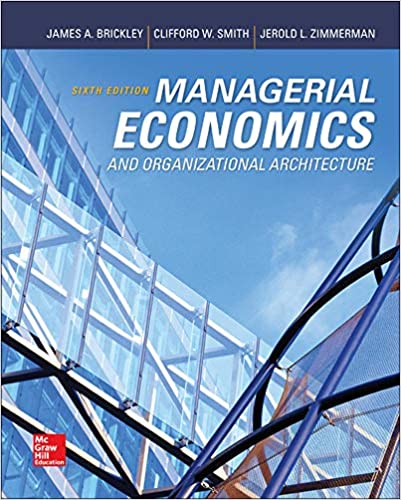
Managerial Economics & Organizational Architecture 6th Edition by James Brickley , Clifford Smith ,Jerold Zimmerman
Edition 6ISBN: 978-0073523149
Managerial Economics & Organizational Architecture 6th Edition by James Brickley , Clifford Smith ,Jerold Zimmerman
Edition 6ISBN: 978-0073523149 Exercise 40
ANALYZING MANAGERIAL DECISIONS: Risk Aversion versus Risk Taking
Lauren Arbittier decides to bet $2,000 on number 35 of the roulette wheel in a Las Vegas casino. Almost immediately she starts to question her decision. Lauren normally is a risk avoider who hardly ever gambles. But she works at Trilogy Software where the CEO understands that taking risks and suffering the consequences are critical to the firm's success. The CEO wants to develop people who take chances. "You don't win points... for trying." Lauren is participating in Trilogy's three-month training program for all new recruits. It educates employees about, among other things, how to evaluate risky projects, not just to immediately accept or reject the project because it is risky. The program also suggests to employees that they will not be rewarded at Trilogy unless they take risks. Thus, although Lauren does not like taking risks, working for Trilogy, she has economic incentives to do so.
There are at least three ways in which the Trilogy training program might be effective: (1) It changes employees' preferences regarding risk bearing. (2) It more effectively identifies individuals with the risk tolerances that Trilogy desires. (3) It better communicates the consequences to Trilogy employees of undertaking risky ventures. Discuss the likely importance of these three mechanisms.
Source: E. Ramstad (1998), "High Rollers, How Trilogy Software Trains Its Raw Recruits to Be Risk Takers," The Wall Street Journal (September 21), A1.
Lauren Arbittier decides to bet $2,000 on number 35 of the roulette wheel in a Las Vegas casino. Almost immediately she starts to question her decision. Lauren normally is a risk avoider who hardly ever gambles. But she works at Trilogy Software where the CEO understands that taking risks and suffering the consequences are critical to the firm's success. The CEO wants to develop people who take chances. "You don't win points... for trying." Lauren is participating in Trilogy's three-month training program for all new recruits. It educates employees about, among other things, how to evaluate risky projects, not just to immediately accept or reject the project because it is risky. The program also suggests to employees that they will not be rewarded at Trilogy unless they take risks. Thus, although Lauren does not like taking risks, working for Trilogy, she has economic incentives to do so.
There are at least three ways in which the Trilogy training program might be effective: (1) It changes employees' preferences regarding risk bearing. (2) It more effectively identifies individuals with the risk tolerances that Trilogy desires. (3) It better communicates the consequences to Trilogy employees of undertaking risky ventures. Discuss the likely importance of these three mechanisms.
Source: E. Ramstad (1998), "High Rollers, How Trilogy Software Trains Its Raw Recruits to Be Risk Takers," The Wall Street Journal (September 21), A1.
Explanation
Lauren Arbittier works at Trilogy Softwa...
Managerial Economics & Organizational Architecture 6th Edition by James Brickley , Clifford Smith ,Jerold Zimmerman
Why don’t you like this exercise?
Other Minimum 8 character and maximum 255 character
Character 255


